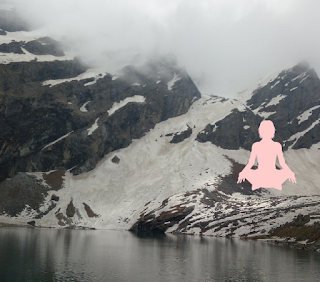How to do Padam Asana | How Padam asana is benificial to do in winter
Padam asana, siddha asana, Swastika asana and sukh asana; these are the four asanas which are prescribed
for the purposes of meditation and spiritual growth. Aspirant can sit in any
one of four asanas at a stretch for more than one hour with steady mind and acquire
consciousness as well as infinite peace.
Today, we learn about Padam asana.
Padam asana is also known as the Lotus
position, which is one of the classic postures aimed for meditation and
pranayama that attributes one’s spiritual evolution. Padam asana makes the entire
body attain a resting state and keeps the prana energy flow more actively in
the body. The mind gets rejuvenated as the metabolism slows down and the longer
you hold this asana the quicker the major Nadis such as Ida, Pingla and
Sushumna become balanced naturally with continual practise. Padam asana makes
ankles, knees, hips, spine and neck more flexible along with the nerves of the
entire body. For beginners, Padam asana can be difficult to perform but after a
few days of practice, it becomes easy. One can do half Padam asana first in
preparation for the full Padam asana.
Asanas, pranayama and meditation
provide sufficient prana energy to the body’s muscles and cells, as well as
purifying the blood to meet their daily requirements. Padam Asana is excellent
in this context as it keeps the body strong and flexible by enhancing the
strength of the psoas muscles as well, which is the bridge between the lower
body muscles and upper body muscles. Psoas muscles keeps the lower body and
upper body in perfect synchronisation.
Padam asana can help you breathe
easy in the winter when you do pranayama in this asana, just for five minutes
daily. Winter are known to cause increase in respiratory symptoms like cough,
cold, fiver, throat problems, and congestion in small children and elder due to
infection and allergies. Sitting in this asana, Diaphragmatic breathing/ deep
breathing is more beneficial in the winter. Belly expands during in diaphragmatic
breathing and is done by contracting the diaphragm, air enters the lungs and
while the chest does not rise. Second method to do is inhaling through the nose
and exhaling through the mouth for ten times and follow the same as above
described.
Padam
asana:
Find a quiet place and sit down
on the ground with legs straight in front.
Fold the legs by placing the left
foot on the right thigh and the right foot on left thigh.
Place both the heels as near to the
abdomen as possible while knees touch the ground.
Rest hands on the knees with the
palms facing upwards with the index finger touching the middle portion of the
thumb, spine lengthening up.
Shoulders should be remain loose
and arms fairly straight.
Breathe naturally.
Sit in this asana for as long as
possible.
Benefits:
Padam asana strengthens legs,
waist, shoulders and spine resulting in good posture. Enhances the respiration
rhythmically and balances the mind. It can help ladies with menstrual
discomfort and sciatica. As well as restoring energy levels.



Very nice sir👌👍
ReplyDeleteGood
ReplyDeleteNice explanation about padmasan
ReplyDelete👍👍👍
ReplyDeleteThere are several studies that affirm this theory. One of them, carried out by the American Lung Society, showed that meditation is even more effective than smoking cessation programs and, in addition, the duration of its effect is even greater than that of traditional treatments. This may be because meditation helps to unlink the desire for the act of smoking.
ReplyDelete